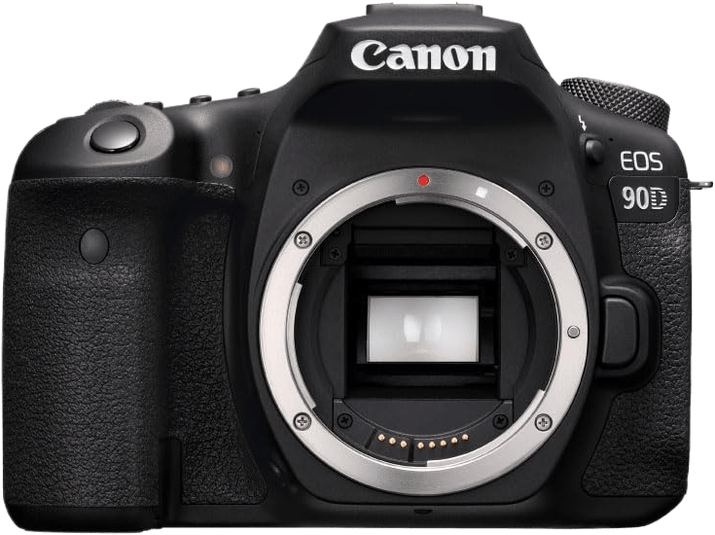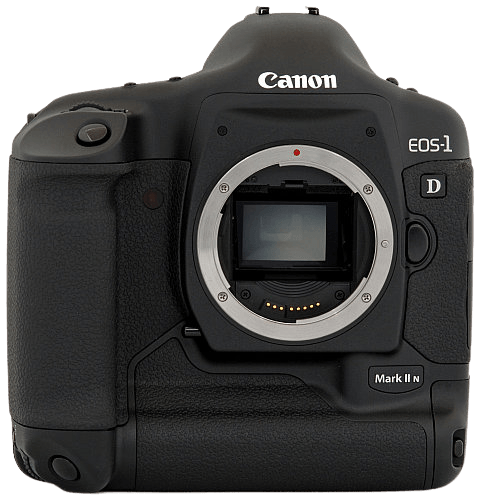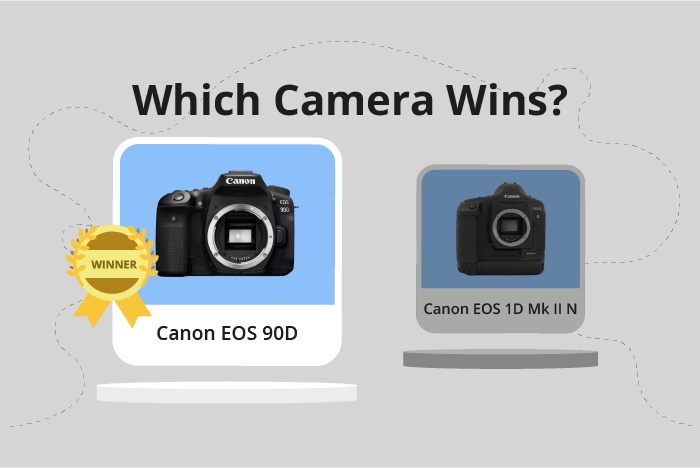Canon EOS 90D vs EOS 1D Mark II N Comparison
Canon EOS 90D

Canon EOS 1D Mark II N

The Canon EOS 90D outperforms the Canon EOS 1D Mark II N with a score of 67 to 40. Both cameras share the DSLR type and have similar dimensions, with the 90D being slightly smaller and lighter. The 90D, released in 2019, is a more recent model than the 1D Mark II N, which launched in 2005.
The 90D’s higher score reflects its better performance and updated technology. Its advantages include a lower launch price of $1199 compared to $5986 for the 1D Mark II N. Additionally, the 90D is more portable with a weight of 1.55lbs, while the 1D Mark II N weighs 3.45lbs.
Despite its lower score, the 1D Mark II N has a more robust build due to its larger size and weight. However, the Canon EOS 90D’s higher score, modern features, and affordability make it the superior choice between the two models.
Canon EOS 90D vs EOS 1D Mark II N Overview and Optics
The Canon EOS 90D outperforms the Canon EOS 1D Mark II N in optics, with a score of 62/100 compared to the latter’s 46/100. Both cameras share several specifications, including CMOS sensor type, Canon lens mounts, and the absence of image stabilization. However, the 90D takes the lead in certain aspects, while the 1D Mark II N excels in others.
The Canon EOS 90D boasts 33 megapixels, significantly more than the 1D Mark II N’s 8.2 megapixels. This difference allows the 90D to capture finer details and produce higher resolution images. Additionally, the 90D has a faster shooting speed of 10 frames per second, compared to the 1D Mark II N’s 8.5 frames per second. This enables the 90D to capture fast-moving subjects with greater ease. Furthermore, the 90D is equipped with a more advanced Digic 8 processor, which improves image processing capabilities and overall performance.
On the other hand, the Canon EOS 1D Mark II N has a higher DXOMARK sensor score of 66, compared to the 90D’s 58. This indicates that the 1D Mark II N’s sensor performs better in terms of color depth, dynamic range, and low-light performance. The 1D Mark II N also has a larger APS-H sensor size, which contributes to its superior sensor performance.
Taking into account these differences, the Canon EOS 90D is the superior camera in terms of optics due to its higher megapixel count, faster shooting speed, and advanced processor. However, the Canon EOS 1D Mark II N still has its merits with a better-performing sensor and larger sensor size. Ultimately, the choice between these two cameras will depend on the specific needs and priorities of the photographer.
Canon EOS 90D vs EOS 1D Mark II N Video Performance
When comparing the video capabilities of the Canon EOS 90D and the Canon EOS 1D Mark II N, it quickly becomes apparent that the latter does not possess any video functionality. Therefore, this comparison will focus on the video features of the Canon EOS 90D.
The Canon EOS 90D has a video score of 91 out of 100, indicating its strong performance in this area. Its maximum video resolution is 4K, with dimensions of 3840 x 2160 pixels. This high resolution enables the capture of crisp and detailed footage. The camera also supports a maximum video frame rate of 120fps, allowing for smooth slow-motion videos when desired.
Additionally, the Canon EOS 90D includes built-in time-lapse functionality. This feature allows users to create stunning time-lapse videos without the need for external software or additional equipment.
Taking these factors into account, it is clear that the Canon EOS 90D offers impressive video capabilities, while the Canon EOS 1D Mark II N lacks this feature entirely. For those who prioritize video recording in their photography endeavors, the Canon EOS 90D is the superior choice between these two models.
Canon EOS 90D vs EOS 1D Mark II N Features and Benefits
The Canon EOS 90D outperforms the Canon EOS 1D Mark II N in features, with a score of 83/100 compared to the latter’s 17/100. Both cameras share some specifications, such as a lack of GPS functionality. However, the EOS 90D excels in several areas, making it the superior option in terms of features.
The EOS 90D boasts a 3-inch touchscreen with a resolution of 1,040,000 dots, while the 1D Mark II N has a smaller 2.5-inch screen without touch capabilities and a lower resolution of 230,000 dots. The 90D’s flip screen adds to its versatility, allowing for more comfortable shooting in various angles. Additionally, the EOS 90D includes both Wi-Fi and Bluetooth connectivity, enabling seamless file transfers and remote control options. The 1D Mark II N does not offer such wireless features.
The EOS 1D Mark II N does not surpass the EOS 90D in any specific feature; instead, it simply shares the absence of GPS with the 90D. The significant difference in feature scores reflects the EOS 90D’s superiority in this comparison.
Considering the shared and differing specifications, the Canon EOS 90D is the clear winner in terms of features. Its larger, high-resolution touchscreen, flip screen, and wireless connectivity make it a more versatile and user-friendly option compared to the EOS 1D Mark II N. While both cameras lack GPS, the EOS 90D’s other advantages solidify its position as the superior choice for photographers seeking a camera with robust features.
Canon EOS 90D vs EOS 1D Mark II N Storage and Battery
The Canon EOS 1D Mark II N outperforms the Canon EOS 90D in storage and battery capabilities, with a score of 79/100 compared to the 90D’s 48/100. Both cameras lack USB charging and accept SD memory cards. However, the 1D Mark II N has an advantage with two memory card slots and compatibility with Compact Flash (Type I or II) cards.
The EOS 90D has a slightly longer battery life of 1300 shots, using the LP-E6N battery type. In contrast, the 1D Mark II N offers 1200 shots with its NP-E3 battery. Despite this difference, the 1D Mark II N remains superior in storage options, making it a more versatile choice for professional photographers.
Although the EOS 90D has a marginally better battery life, the 1D Mark II N’s superior storage capabilities make it the better option for those who require flexibility and additional storage. Both cameras have their strengths, but the 1D Mark II N’s storage capabilities give it an edge in this comparison.
Canon EOS 90D vs EOS 1D Mark II N – Our Verdict
Are you still undecided about which camera is right for you? Have a look at these popular comparisons that feature the Canon EOS 90D or the Canon EOS 1D Mark II N:

